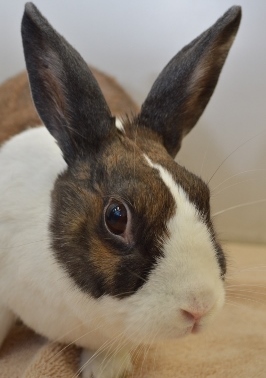
Can you believe January is almost over already? Neither can we! And this means our time with the rabbit as our Animal of the Month for January is up. We hope you enjoyed following us on Twitter @ExoticPetVets as we tweeted all month about rabbits. But just in case you missed any, we have a summary for you here. Did you know?:
- Many people think that rabbits (Oryctolagus cuniculus) are rodents, but they’re not. They are lagomorphs.
- Rabbits are lagomorphs because they have two sets of upper incisor teeth. The second set is smaller and hidden behind the first.
- Another reason rabbits are lagomorphs is they eat only plant matter, while many rodents eat both animal and plant matter.
- It’s believed the superstition of the lucky rabbit’s foot can be traced as far back to the Celtics in 600 BC.
- Some sources say the Celtics believed rabbits could communicate with spirits since they spent so much time underground.
- Rabbits have long curved ears, the shape of which helps amplify sound to give them an excellent sense of hearing.
- Keen hearing is critical for rabbits’ survival. They’re a prey species and need to hear sounds from predators.
- The ability rabbits have to move their ears helps them locate sounds, which is vital in detecting predators.
- Like cats, rabbits also move their ears as a way of communicating through body language.
- Rabbits’ large ears help them regulate their body temperatures as they can’t sweat like we do.
- Rabbits can increase blood flow to their ears, which contain large veins.
- Rabbits can also move their ears to catch a cool breeze if they feel too hot.
- Lop eared rabbits were selectively bred to have ears that hang down.
- Their low-hanging ears impede lop eared rabbits’ ability to hear, communicate & thermoregulate compared to other rabbits.
- Rabbits’ eyes are positioned on the sides of their heads which gives them panoramic vision.
- Rabbits don’t have to move their heads to see in all directions. They also have keen long distance and night vision.
- As a prey species, rabbits need excellent vision to help them evade predators.
- Rabbits have trouble seeing the area beneath their mouths and rely on their sensitive lips and whiskers to recognize food.
- When rabbits are happy they’ll express it with their signature move called a “binky.”
- A “binky” is when rabbits jump around while flicking their feet and twisting their heads.
- When properly socialized and handled, rabbits can be loving, gentle and pleasant members of the family.
- While dogs and cats are well-known therapy animals, many people turn to rabbits for comfort.
This is the second time that rabbits were our featured creatures for Animal of the Month. Check out our blog post from January 2014 to see what we tweeted about rabbits the first time around!

